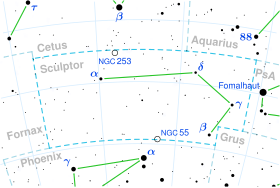
Summary
R Sculptoris is a variable star system in the southern constellation of Sculptor.[9][10] Parallax measurements provide a distance estimate of approximately 1,435 ± 98 light-years from the Sun.[1] An independent estimate based on measurements of an ejected shell surrounding the star yield a distance of 1,180 ± 140 light-years.[11] The star is drifting closer with a radial velocity of −5.4 km/s.[5]
| Observation data Epoch J2000.0 Equinox J2000.0 | |
|---|---|
| Constellation | Sculptor |
| Right ascension | 01h 26m 58.09462s[1] |
| Declination | −32° 32′ 35.4377″[1] |
| Apparent magnitude (V) | +5.72[2] |
| Characteristics | |
| Spectral type | C6,5ea(Np)[3] |
| U−B color index | +7.67[2] |
| B−V color index | +3.87[2] |
| Variable type | SRb[4] |
| Astrometry | |
| Radial velocity (Rv) | −5.40[5] km/s |
| Proper motion (μ) | RA: −9.784[1] mas/yr Dec.: −30.900[1] mas/yr |
| Parallax (π) | 2.2724 ± 0.1471 mas[1] |
| Distance | 1,440 ± 90 ly (440 ± 30 pc) |
| Absolute magnitude (MV) | −0.45[6] |
| Details[7] | |
| Mass | 1.3±0.7 M☉ |
| Radius | 138.61+1.24 −0.16[1] R☉ |
| Luminosity | 2,068±171[1] L☉ |
| Surface gravity (log g) | −0.6±0.4 cgs |
| Temperature | 3,306+2 −15[1] K |
| Metallicity [Fe/H] | 0.0[3] dex |
| Other designations | |
| Database references | |
| SIMBAD | data |

This is an aging giant star on the asymptotic giant branch with a stellar classification of C6,5ea(Np),[3] which indicates a carbon-rich atmosphere. It is a semi-regular pulsating star of the SRb[4] type that is nearing the end of its fusing lifespan. A sine curve fitted to the last ten pulsation cycles prior to 2017 give a pulsation period of 376 days with an amplitude of 0.75 magnitude. The star is shedding its outer atmosphere, and it is surrounded by a thin shell of dust and gas that was created during the most recent thermal pulse around 2,000 years ago.[11]
Observations have revealed a spiral structure in the material around the star.[13] The spiral is suspected to be caused by an unseen companion star.[9] The spiral windings are consistent with an orbital period of ~350 years.[13]
Gallery edit
-
This image captures approximately 20x20 milliarcseconds.[14]
-
Spiral spotted by ALMA around the star (data visualisation).
-
R Sculptoris and its hidden companion, taken by Hubble Space Telescope
References edit
- ^ a b c d e f g h i Brown, A. G. A.; et al. (Gaia collaboration) (August 2018). "Gaia Data Release 2: Summary of the contents and survey properties". Astronomy & Astrophysics. 616. A1. arXiv:1804.09365. Bibcode:2018A&A...616A...1G. doi:10.1051/0004-6361/201833051. Gaia DR2 record for this source at VizieR.
- ^ a b c Ducati, J. R. (2002). "VizieR Online Data Catalog: Catalogue of Stellar Photometry in Johnson's 11-color system". CDS/ADC Collection of Electronic Catalogues. 2237. Bibcode:2002yCat.2237....0D.
- ^ a b c Cruzalèbes, P.; et al. (2013). "Fundamental parameters of 16 late-type stars derived from their angular diameter measured with VLTI/AMBER". Monthly Notices of the Royal Astronomical Society. 434 (1): 437. arXiv:1306.3288. Bibcode:2013MNRAS.434..437C. doi:10.1093/mnras/stt1037. S2CID 49573767.
- ^ a b Samus, N. N.; et al. (2009). "General Catalogue of Variable Stars (Samus+ 2007-2013)". VizieR On-line Data Catalog: B/GCVS. Originally Published in: 2009yCat....102025S. 1. Bibcode:2009yCat....102025S.
- ^ a b Gontcharov, G. A. (2006). "Pulkovo Compilation of Radial Velocities for 35 495 Hipparcos stars in a common system". Astronomy Letters. 32 (11): 759–771. arXiv:1606.08053. Bibcode:2006AstL...32..759G. doi:10.1134/S1063773706110065. S2CID 119231169.
- ^ Anderson, E.; Francis, Ch. (2012), "XHIP: An extended hipparcos compilation", Astronomy Letters, 38 (5): 331, arXiv:1108.4971, Bibcode:2012AstL...38..331A, doi:10.1134/S1063773712050015, S2CID 119257644
- ^ Wittkowski, M; et al. (2017). "Aperture synthesis imaging of the carbon AGB star R Sculptoris. Detection of a complex structure and a dominating spot on the stellar disk". Astronomy & Astrophysics. 601: A3. arXiv:1702.02574. Bibcode:2017A&A...601A...3W. doi:10.1051/0004-6361/201630214. S2CID 56160169.
- ^ "R Scl". SIMBAD. Centre de données astronomiques de Strasbourg. Retrieved 2020-12-06.
- ^ a b "Hubble Gazes at R Sculptoris and its Hidden Companion". SpaceDaily. 11 January 2015.
- ^ "Curious spiral spotted by ALMA around red giant star R Sculptoris (data visualisation)". Image Archive. ESO. Retrieved 11 October 2012.
- ^ a b Maercker, M.; et al. (April 2018). "An independent distance estimate to the AGB star R Sculptoris". Astronomy & Astrophysics. 611: 8. arXiv:1711.09676. Bibcode:2018A&A...611A.102M. doi:10.1051/0004-6361/201732057. S2CID 56318815. A102.
- ^ "ASAS All Star Catalogue". The All Sky Automated Survey. Retrieved 8 December 2021.
- ^ a b Maercker, M.; et al. (2012). "Unexpectedly large mass loss during the thermal pulse cycle of the red giant star R Sculptoris". Nature. 490 (7419): 232–4. arXiv:1210.3030. Bibcode:2012Natur.490..232M. doi:10.1038/nature11511. PMID 23060194. S2CID 4417744.
- ^ "A red giant sheds its skin". www.eso.org. Retrieved 12 February 2018.
Further reading edit
- Nola Taylor Redd (October 11, 2012). "Strange Star Spiral Offers Clues to Sun's Fate". SPACE.com. Scientific American. Retrieved 31 October 2012.



